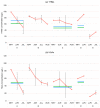Evaluation of Drinking Water Disinfectant Byproducts Compliance Data as an Indirect Measure for Short-Term Exposure in Humans
- PMID: 28531123
- PMCID: PMC5451998
- DOI: 10.3390/ijerph14050548
Evaluation of Drinking Water Disinfectant Byproducts Compliance Data as an Indirect Measure for Short-Term Exposure in Humans
Abstract
In the absence of shorter term disinfectant byproducts (DBPs) data on regulated Trihalomethanes (THMs) and Haloacetic acids (HAAs), epidemiologists and risk assessors have used long-term annual compliance (LRAA) or quarterly (QA) data to evaluate the association between DBP exposure and adverse birth outcomes, which resulted in inconclusive findings. Therefore, we evaluated the reliability of using long-term LRAA and QA data as an indirect measure for short-term exposure. Short-term residential tap water samples were collected in peak DBP months (May-August) in a community water system with five separate treatment stations and were sourced from surface or groundwater. Samples were analyzed for THMs and HAAs per the EPA (U.S. Environmental Protection Agency) standard methods (524.2 and 552.2). The measured levels of total THMs and HAAs were compared temporally and spatially with LRAA and QA data, which showed significant differences (p < 0.05). Most samples from surface water stations showed higher levels than LRAA or QA. Significant numbers of samples in surface water stations exceeded regulatory permissible limits: 27% had excessive THMs and 35% had excessive HAAs. Trichloromethane, trichloroacetic acid, and dichloroacetic acid were the major drivers of variability. This study suggests that LRAA and QA data are not good proxies of short-term exposure. Further investigation is needed to determine if other drinking water systems show consistent findings for improved regulation.
Keywords: Haloacetic acids; Trihalomethanes; birth outcomes; disinfection byproducts; drinking water; exposure assessment; locational running annual average; temporal variability.
Conflict of interest statement
The authors declare no conflict of interest.
Figures




References
-
- CDC (Centers for Disease Control and Prevention) Achievements in Public Health. [(accessed on 21 May 2016)]; Available online: https://www.cdc.gov/mmwr/preview/mmwrhtml/mm4829a1.htm.
-
- Richardson S.D. In: Encyclopedia of Environmental Analysis and Remediation. Meyers R., editor. Volume 3. Wiley; New York, NY, USA: 1998. pp. 1398–1421.
-
- Pressman J.G., Richardson S.D., Speth T.F., Miltner R.J., Narotsky M.G., Hunter S.E., Rice G.E., Teuschler L.K., Mcdonald A., Parvez S., et al. Concentration, chlorination, and chemical analysis of drinking water for disinfection byproduct mixtures health effects research. Environ. Sci. Technol. 2010;44:7184–7192. doi: 10.1021/es9039314. - DOI - PubMed
-
- Singer P.C. Control of disinfection by-products in drinking water. J. Environ. Eng. 1994;120:727–744. doi: 10.1061/(ASCE)0733-9372(1994)120:4(727). - DOI
MeSH terms
Substances
LinkOut - more resources
Full Text Sources
Other Literature Sources
Medical
Research Materials
Miscellaneous

